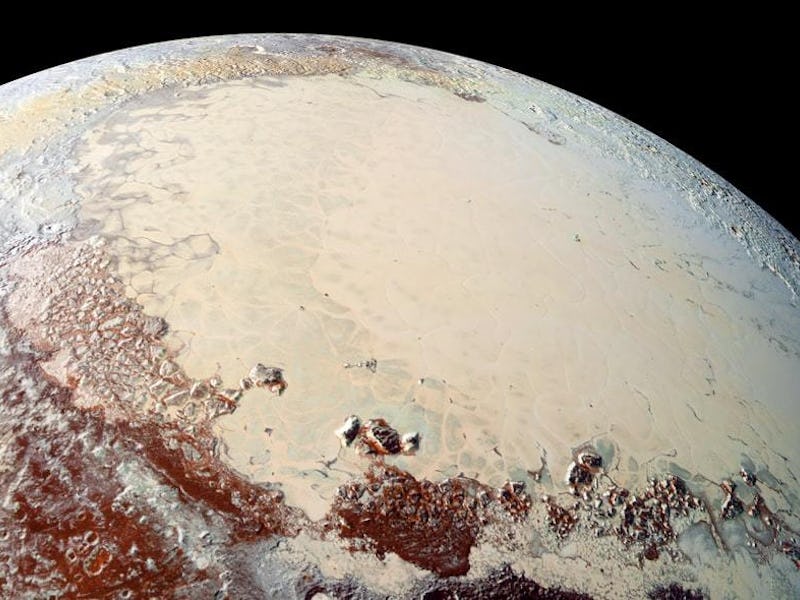Pluto is hiding a massive secret. The tiny icy world in the outer depths of the solar system could in fact, be concealing a subsurface ocean beneath its frozen, heart-shaped region known as Sputnik Planitia. The big question is: Could that subsurface ocean support extraterrestrial life?
First spotted by the New Horizons spacecraft during its historic 2015 flyby, the heart-shaped region that captured the affections of space-lovers everywhere was found by scientists to be was naturally divided into two lobes: A smooth, icy lobe named Sputnik Planitia, and a rougher region known as Tombaugh reggio.
The region informally named Sputnik Planitia is a deep basin thought to be a remnant of an ancient collision. The would-be crater has been filled in over time with a mixture of three kinds of ices — frozen nitrogen, methane and carbon monoxide — and is located on the surface opposite of Charon (which is Pluto’s large, tidally locked moon).
“Sputnik Planitia is one of Pluto’s crown jewels, and understanding its origin is a puzzle,” New Horizons Principal investigator Alan Stern, of the Southwest Research Institute, Boulder, Colorado, explained in a news release.
Pluto's icy heart could be hiding a subsurface ocean.
William McKinnon, professor of earth and planetary sciences in Arts & Sciences at Washington University in St. Louis is a member of the New Horizons team as well as a co-author on several Pluto papers, including one earlier this summer explaining that Pluto’s modest internal heat, is creating a lava lamp effect in Sputnik Planitia. McKinnon also co-authored another paper suggests any potential subsurface ocean would span some 600 miles wide and more than 50 miles thick. He also estimates that such an ocean would have an abundance of ammonia.
The New Horizons team previously detected the presence of ammonia on Charon, and also on one of Pluto’s small moons. “So it’s almost certainly inside Pluto,” McKinnon explained in a news release. “What I think is down there in the ocean is rather noxious, very cold, salty and very ammonia-rich almost a syrup.”
Could life survive in such an environment? If we’re talking about life as we know it, probably not. (Sorry Jeff Goldblum).
“It’s no place for germs, much less fish or squid, or any life as we know it,” McKinnon elaborated. “But as with the methane seas on Titan — Saturn’s main moon it raises the question of whether some truly novel life forms could exist in these exotic, cold liquids.”
Tardigrades are hearty organisms that can survive in extreme environments.
Life on Earth can tolerate a lot. Organisms known as extremophiles don’t just live, but thrive in the harshest environments. For instance, there are organisms that can tolerate extreme temperatures, as well as very salty conditions, or even the tardigrade, which can dry out for long periods of time and then reanimate thanks to a few drops of water.
It’s cold as hell out in the Kuiper Belt, so in order for a subsurface ocean on Pluto to remain a liquid, there must be some sort of anti-freeze, such as ammonia. Although scientists are not convinced there’s an organism out there that could survive in the viscous, ammonia-rich ocean on Pluto, certain types of bacteria found here on Earth are able to convert nitrogen into ammonia.
If there is an ocean lurking beneath Pluto’s icy heart, it would be a major discovery. Pluto is just one of thousands of worlds taking up residence in the Kuiper Belt, and if an exotic — meaning different than what we find here on Earth — subsurface ocean could be confirmed, the probability of other KBO’s harboring exotic oceans (and maybe life) increases exponentially.
New Horizons was decades in the making, and there are no other missions to explore Pluto currently on the books. If we want to definitively confirm a subsurface ocean exists, we will need to send another orbiter (or better yet, a lander) to collect crucial gravity measurements.
